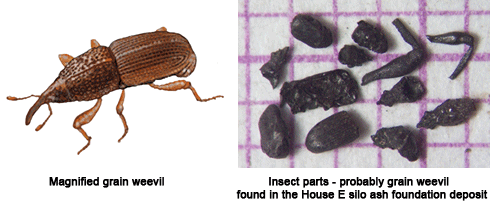by Claire Malleson
The excavations this season have all taken place in or around the Silo Building Complex (SBC) to the east of the Khentkawes town area. These excavations began in 2012, and the results of work by specialists on those materials helped us decide where to dig this year. Each specialist had a set of questions about their materials based on the results from 2012. Now we are starting to have a look at the materials excavated this year, hoping to answer some of our questions!
The questions I have about the plant remains from SBC 2014 excavations are based on both the 2012 SBC materials and the plant remains from House E in the nearby Khentkawes town which I spent 6 months studying in 2013 (See AERAgram 14:2 for some preliminary results of this).
One of the most interesting features for me in the House E botanical samples was a large deposit of ash which had been laid down as a foundation beneath a set of four silos to act as insecticide – repelling grain weevils.

Some of the ash had probably been gathered from kitchens and bakeries in the House E, the rest was from heaps of straw burned specifically to bulk out this foundation material. The charred plants preserved in these ashes were in incredibly good condition, very well preserved and far more easily identified than the plants we find in the Lost City of the Pyramids (also called Heit el-Ghurab). Because they were so well preserved I was able to determine exactly which specific plants species the seeds had come from. Usually it has only been possible to identify the plants very generally e.g. Clover family, Dock and Sorrel type, Rushes and reeds, Canarygrass type. With many of the plants in House E I was able to be far more specific.
These photographs are of some of the House E charred seeds:

Because of all this additional information about the plant species, I have been able to learn a great deal about local agriculture and ecology as well as household activities. For example, I can tell that these plants were growing as weeds in cereal crops (wheat and barley); all over Egypt the “rubbish” leftover from cleaning cereals was common and invaluable household fuel used instead of wood – which was far more expensive. On a daily basis the inhabitants would have had to spend many hours preparing the cereals for grinding; removing all the chaff and sieving out the weed seeds – which was then burned in hearths, ovens and bakeries. The presence (in the ash) of the seeds from a combination of both reeds and rushes which like wet areas (e.g. the Common Spikerush) and plants that prefer drier sandier soils, tells me that these crops were growing on the edges of the floodplain area.
The layout of the SBC granaries closely resemble the House E granaries so I am hoping to find a similar ash foundation layer. If that is the case, a detailed study of the SBC ashes will contribute a great deal to what we know about this building. With any luck the ashes will be equally well-preserved as those from House E, and I will be able to make detailed comparisons between the two. Any differences might suggest things such as crops coming from a different area of cultivation land i.e. if they came from wetter areas this could indicate that they were ‘imported’ in from the Delta area. If the ashes happen to be mainly wood-charcoal rather than cereal chaff ash, then I might surmise that the SBC was not a ‘normal’ household, but instead was a more ‘official’ building – supplied with wood to burn in its hearths and ovens (wood is a far more efficient fuel, but far more expensive).
I am looking forward to getting into the Giza field-lab to begin my analysis now the excavations are complete and my samples are waiting for me!
